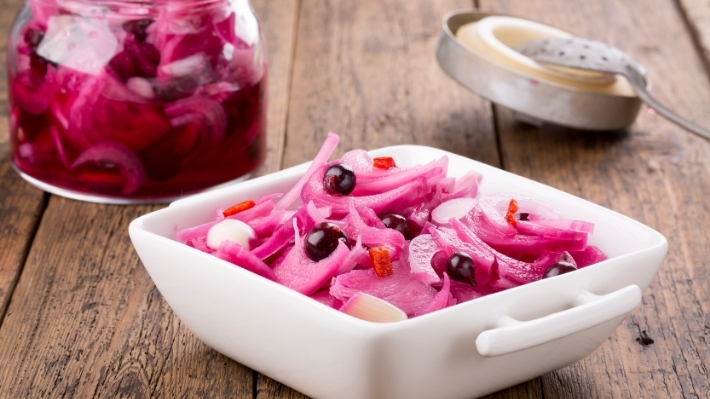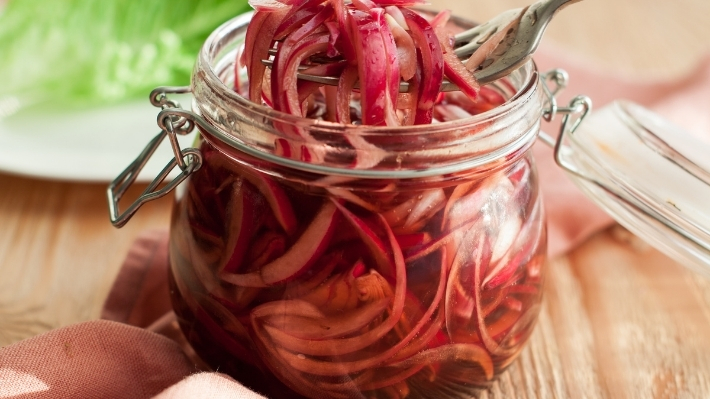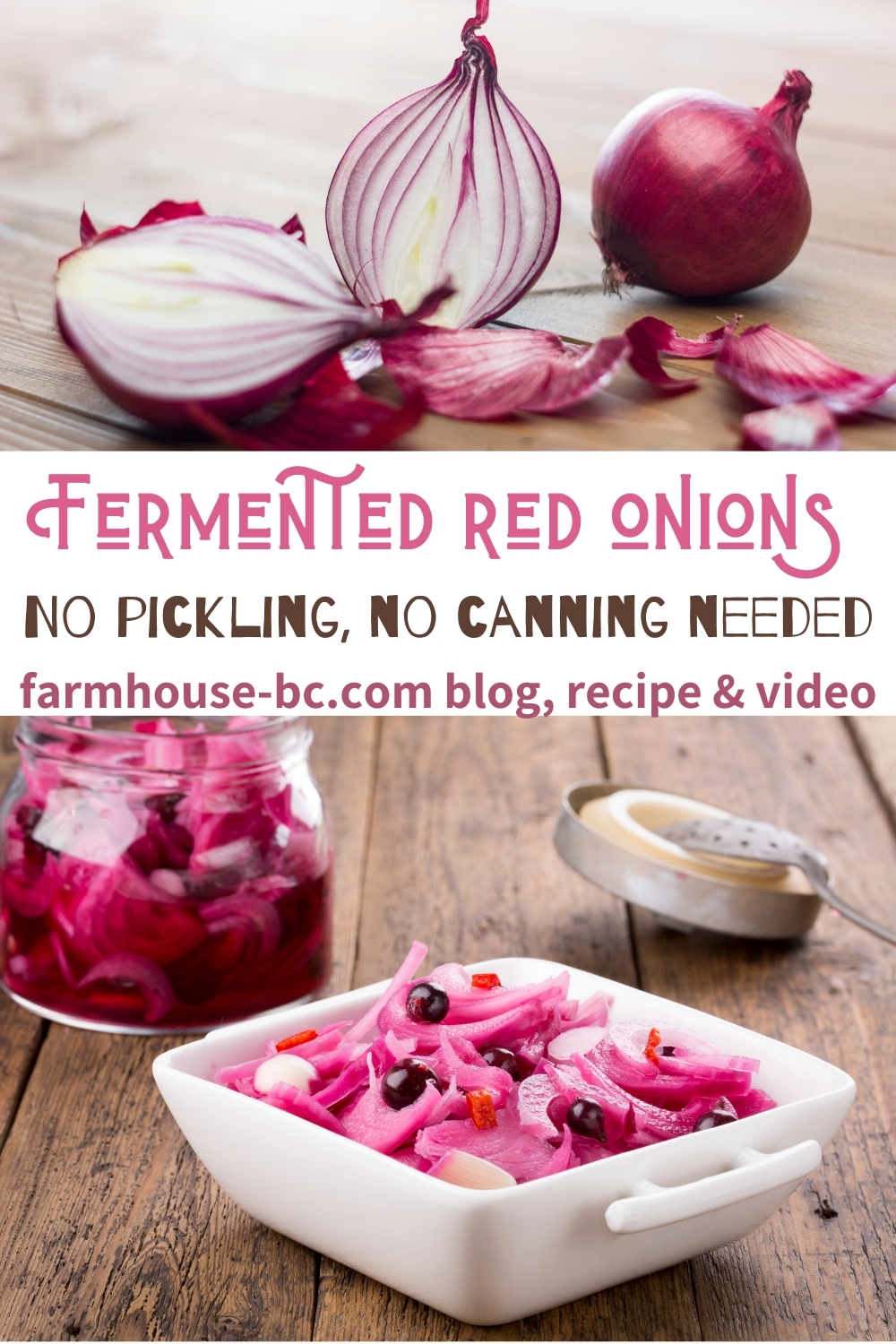Table of Contents or Collapse to Hide
How to ferment red onions
How to ferment red onions for gut health and rich probiotics is so easy. All you need to make fermented red onions are 2 red onions, salt brine, and a week is all you need to have tasty fermented onions! The onions will last at least 9 months in the fridge. No canning lids and processing is needed for this recipe.
Easy fermented onions recipe in just one jar! You don’t have to can or water-bath these in a canner! You can make fermented onions any time of year. Do you have whole peppercorns, hot peppers, or garlic in your garden this year? Spicy fermented onions can be easily made.
I love fermenting because it will last a very long time in the fridge and there is no canning, cooking, or processing the foods. Besides, you are getting the added gut-health benefits that fermented food gives.
Interested what 11 plants to regrow from cuttings like the onions? The blog post can be found 11 Plants to Regrow From Cuttings.
Ingredients for fermented onions
[embedyt] https://www.youtube.com/watch?v=nxfQ8aS4nJY[/embedyt]
- 2 large red firm onions
- 2 tablespoons of sea salt (little less if needed)
- 4 cups of filtered room temperature water
- Peppercorns (1-2 tablespoons)
- Spicy peppers, onions or garlic
What is the difference between pickled and fermented onions?
Most pickled foods are done with vinegar. Lacto-fermented is done with food, salt, and water. Pickled foods are made “pickled” by using an acid such a vinegar to achieve their sour taste. While fermented foods are naturally made sour-tasting by the food’s sugar and natural bacterial to dance and mingle, creating a perfect marriage of sourness. Not to mention more vitamins. Vinegar will actually kill the bad and the good bacteria during the pickling process. One reason, I do not pickle my foods.
What other foods can I ferment?
- corn
- radishes
- cabbage
- coleslaw
- lemons
- cauliflower
- jalapenos
- pickles
Do you want to learn more about fermenting?
- If you would like to learn how to make fermented pickles, one jar, no canning or processing needed, see that Easy fermented pickles, no canning!.
- Fermenting carrots is so easy and fun, that blog and video can be seen Fermented carrots for gut health.
- Fermented coleslaw is awesome to make as well as easy, learn how-to Fermented coleslaw recipe.
Should you wash vegetables before fermenting?
This is one of those questions that there is a split in opinion. On one hand, people will say, rather argue, that washing fruit and vegetables is necessary and can kinder the lactobacillus bacteria from doing “its job”. I disagree, I have never, ever had anything I fermented, not fermented because I pre-washed it with our veggie soap.
How long to ferment onions?
How long to ferment onions depends on your flavor buds and the temperature at the time of making the onions. I usually do a 5-10-day ferment then I put the fermented foods in cold storage in the summer. But since I make these all year long, jar by jar, in the winter it may sit the full 10-days on the counter.
If you decide to keep the fermented foods on the counter, just realize they will become sourer and sourer because they will continue to ferment. Yes, they will be loaded, really loaded with Lacto-bacteria which is the best for the gut but I cannot eat them once they become too sour if left to ferment on the counter.
Storing fermented onions
Once you make the fermented onions and let them sit for 5-10 days on the counter, storing them is as easy as opening the fridge door. You do not process these fermented onions by a canning method. Just storing them in cold storage is all that is required. Just remove the glass weight, silicone, and linen cover (if using) and replace it with a spill-proof lid. (See the shop section for all links)
I would suggest using the onions within the first 9 months. If during this time any surface scum appears you will need to remove it. The compost will love you for it. But, if the mold is a fuzzy pink and smells offensive, ditch them all. Your senses should tell you if you want to eat it or not.
Gnats and fruit flies can be a nuisance with fermenting and making sourdough, read more about “How to control gnats and fruit flies naturally” HERE.
Fermenting foods with UV jars
I always make and store all fermented foods in UV jars. For one, I don’t want light filtering in the food on the counter and breaking down the vitamins. Second, I have a commercial glass door refrigerator that light is able to penetrate. I prefer amber UV jars over any jar out there.
Collect extra spices this summer to use in fermenting all year round, I have a whole blog post on “Drying herbs 101”
Directions for making fermented onions
- Dissolve the sea salt in the water (heating the water may be necessary) but cooled to use
- Slice the onions
- Chop into small to medium pieces (use dicer if preferred)
- Add the cubed onions and (peppercorns-optional) to the jar
- Leave headspace for the brine and glass weight
- Top off with the sea salted water to within an ½ inch from the top
- Add a glass weight
- Place a silicone fermenting lid on with a metal band
- If not using the fermenting lid, use a glass weight and linen or cotton cover, tied tightly
- Leave on the counter 5-10 days
- A plate or bowl may be necessary to catch the over-flow
- Replace silicone lid with the lid of choice
- Refrigerate and enjoy
- Consume within 9 months
** You may find the blog How to clean vegetables and fruit naturally.
Ways to use fermented onions
- raw
- hamburgers
- chili
- hotdogs
- soups
- meatloaf
- casseroles
- meatballs
- steak
- sausage
- salads
- potato salad
- tuna fish
- the rest is endless, literally!
Farmhouse veggie wash can be found on Amazon
Sea salt can be found on Amazon
Ball leak-proof storage lids can be found on Amazon
A veggie brush can be found on Amazon
24 pack flour cotton sack towels can be found on Amazon
Ball quart UV jars can be found on Amazon
Fermenting silicone lids can be found on Amazon
Fermenting glass weights can be found on Amazon
Adjustable slicing Mandolin can be found on Amazon
Rubbermaid Food Savers can be found on Amazon
Rubbermaid Food Savors long can be found on Amazon
OXO vegetable chopper can be found on Amazon



Pingback: Amazing Horseradish Mustard Recipe ⋆ Farmhouse-bc
Pingback: Easy Bison Chili Cooked On A Woodstove ⋆ Farmhouse-bc
Jen, it’s so easy, you can actually use what you have around the house if you don’t want to spend extra on fermenting tools. Check out my fermenting pickles on YouTube that shows how to work around buying the fermenting tools. Let me know what you try, I love to hear new stories 🙂
These sound so good. I’m a newbie to fermenting but love the foods others have been so kind to share. Perhaps it’s time to start making my own!